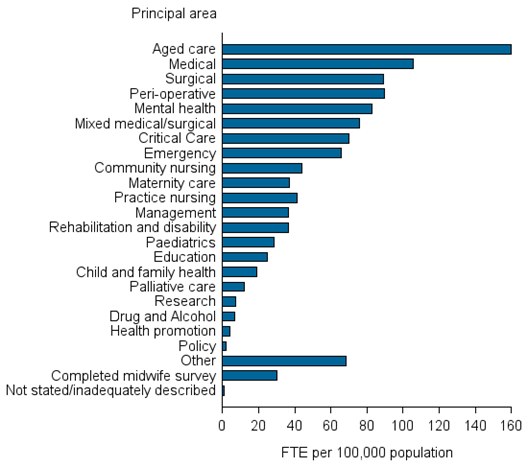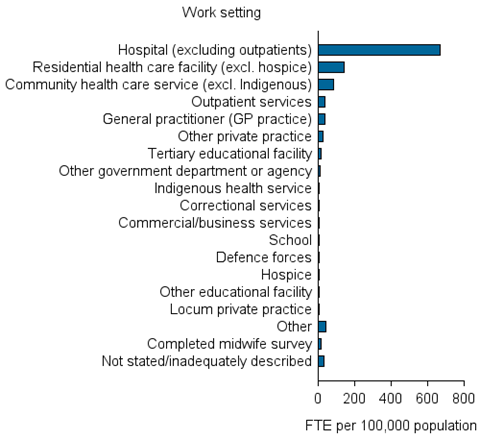Work characteristics of nurses and midwives
Area of nursing and midwifery
Respondents to the workforce survey are asked to indicate their 'principal area of main job', which relates to the type of work that they do. The area that had the greatest supply of nurses and midwives was aged care (159 FTE per 100,000 population).
Figure 1: Employed nurses and midwives in Australia: principal area of main job, FTE rate, 2015

Notes
- 5,090 out of 23,801 respondents stated that they worked identical nursing and midwifery hours. This indicates that a significant number of respondents who filled in the combined nursing and midwifery form may have misinterpreted the wording of the 'hours' questions. Consequently, the FTE rate for maternity care is likely to be overstated.
- 'Completed midwife survey' refers to those midwives who completed a midwife survey form instead of a nurse survey form. The midwife survey consists of different categories of 'principal area of main job', and their responses have been grouped together here. For midwife survey categories of 'principal area of main job', please refer to Focus on midwives.
- Full-time equivalent (FTE) per 100,000 population. FTE is based on total weekly hours worked.
Source: AIHW NHWDS.
Nurses and midwives working in child and family health had the highest average age (49.9 years). Nurses and midwives working in emergency had the lowest average, at 39.4 years. The highest proportion of male nurses was in the area of mental health, where men comprised 30.9% of the workforce.
Working hours
On average, employed nurses and midwives worked 33.5 hours per week in 2015.
Almost half (149,867 or 48.8%) worked less than 35 hours per week.
Across the jurisdictions, there was some variation in average weekly hours worked by nurses and midwives. Nurses and midwives in the Northern Territory worked the most weekly hours on average (38.4 hours), followed by those working in the Australian Capital Territory (35.0 hours). Nurses and midwives in South Australia reported working the least weekly hours on average (31.8).
Nurses and midwives in Very remote areas worked the greatest number of hours, 40.1 hours per week compared with the national average of 33.5. Nurses and midwives in Inner regional areas reported working the least hours (32.5). This was consistent with reported working hours in 2014.
Type of work setting
In 2015, the work setting of employed nurses and midwives with the highest FTE rate was hospitals (excluding outpatient services) (673 FTE per 100,000 population).
Figure 2: Employed nurses and midwives: work setting of main job, FTE rate, 2015

Notes
- 'Completed midwife survey' refers to those midwives who completed a midwife survey form instead of a nurse survey form. The midwife survey consists of different categories of 'principal area of main job', and their responses have been grouped together here. For midwife survey categories of 'principal area of main job', please refer to Focus on midwives.
- Full-time equivalent (FTE) per 100,000 population. FTE is based on total weekly hours worked.
Source: AIHW NHWDS.
Employment sector
In 2015, the total number of nurses and midwives who reported working some hours in the private sector was 113,732. The total number of nurses and midwives who reported working some hours in the public sector was 182,268.
The number of registered nurses working in the public sector was 77% higher than that of the private sector (156,528 compared to 88,675). This was also seen with midwives, with nearly triple the number reporting working in the public sector compared to the private sector (20,011 compared to 7,462).
Among enrolled nurses the difference in number between sectors in 2015 was 683 (25,740 in the public sector compared to 25,057 in the private sector).
| Nursing & midwifery category | Some clinical hours in private sector | Some clinical hours in public sector | Some clinical hours in both sectors | Non-clinical hours only | Total |
|---|---|---|---|---|---|
| Registered nurses(b) | 88,675 | 156,528 | 8,068 | 18,899 | 256,034 |
| Registered midwives(c) | 7,462 | 20,011 | 1,549 | 2,287 | 28,211 |
| Enrolled nurses | 25,057 | 25,740 | 1,239 | 1,512 | 51,070 |
| Total nurses and midwives | 113,732 | 182,268 | 9,307 | 20,411 | 307,104 |
- 'Employed’ is defined as working any hours in either nursing or midwifery in the week before the survey.
- Data for registered nurses also include people with dual registrations and those who were registered as a ‘midwife only’.
- Employed registered midwives who worked any hours as either a midwife or a nurse.
Source: AIHW NHWDS.


